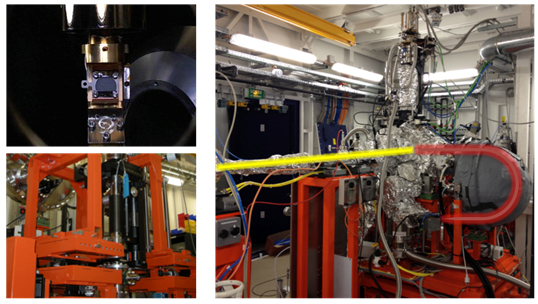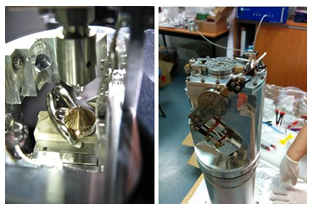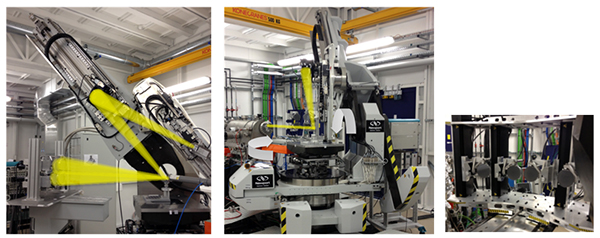The GALAXIES beamline has now reached full speed with the complete opening of the RIXS and HAXPES endstations to users and the publication of the first scientific results. In a recent article issued in J. Synchrotron Radiation, the GALAXIES team provides the technical details and performances of the beamline optics and endstations, along with a selection of scientific results in materials science and diluted phases.
The GALAXIES beamline provides a highly tunable micro-focused x-ray source with high flux and high-energy resolution in the 2.3-12 keV energy range. The beamline novelty lies in the unique set of spectroscopic techniques it offers, namely resonant / non-resonant inelastic x-ray scattering (IXS / RIXS) and hard x-ray photoemission spectroscopy. Both HAXPES and RIXS provide detailed information about the electronic properties of materials, specific to the chemical element and selected orbitals. While RIXS is an all photon technique, well adapted to bulk samples and difficult sample environments (e.g. high pressure cells) because of the high penetration depth of x-ray photons, HAXPES retains the special features and constraints of photoemission - surface sensitivity and the need for UHV conditions - but to a lesser extent as high energy electrons can escape from deep inside the solid (usually several tens of nanometers), and are thus less affected by the surface state.
GALAXIES construction started in 2008-2009 with procurement of beamline instruments, optics and hutch construction was completed in January 2010. The first beam illuminated the experimental hutches in 2011 and the first test experiments were realized in April 2012 for HAXPES and September 2012 for RIXS. By the end of 2012, the beamline was ready to welcome its first users on the HAXPES station, while the first user experiments on the RIXS endstation were scheduled in May 2013 for the first time.
The HAXPES endstation is depicted in Figure 1. The endstation consists of a main chamber under UHV conditions that hosts the electron analyzer, the sample manipulator and a gas cell. The electron analyzer be operated in the 0 – 12 keV kinetic energy region with a 50 meV resolution. Attached to the main chamber, the preparation chamber (also under UHV) serves for sample loading, basic sample treatment (heating, cleaving, sputtering, evaporation), surface characterization (LEED) and transfer to the main analysis chamber. Photoemission can be performed in samples in the solid, liquid or gas phases thanks to adapted environments (cf. Figure 1).


Figure 1: Photos of the HAXPES endstation : Solid samples are mounted on a cryogenic sample holder (Top of photos) that can host two sample plates. In addition, a bias voltage can be applied in-situ polarization ; (bottom left) view of gas cell used for the introduction of gas in the chamber; (middle) overview of the HAXPES endstation showing the direction of the incoming photons (yellow line) and outgoing electrons (red line). A new liquid jet environment is currently under commissioning (Bottom photos).
The RIXS endstation is installed in the second experimental hutch. It offers the possibility to perform IXS, RIXS or more simply X-ray emission spectroscopy (XES) experiments in the hard x-ray range and for a wide range of scattering angles in the vertical or horizontal planes thanks to its versatile design. The horizontal arm can host a 4-analyzer assembly for IXS / RIXS measurements while the vertical arm carries a single analyzer mainly for RIXS studies. The sample is positioned on a heavy-duty tower. Because of the large room around the sample position, the RIXS endstation can host a large variety of sample environments such as a goniometer head, a high pressure cell, a He cryostat, an oven, or a liquid cell – to cite some of the equipment that has already been utilized for RIXS measurements on the beamline.

Figure 2: Photos the RIXS spectrometer. [Left] The direction of the x-ray emission from the sample to the single analyzer and then focused to the detector, all located on the Rowland circle are depicted by the yellow lines. Also shown in the left of the photo is the multi-analyzer set-up mounted on a temporary support which has now been replaced with a permanent fixture [Right]; [Middle] Photo showing the whole spectrometer, with arrows denoting the vertical and horizontal rotations allowed for the single-analyzer arm. The multi-analyzer system can also rotate in the horizontal plane. The airpath from the KB vessel to the sample position has now been replaced with a vacuum tube with Beryllium windows.
The research areas covered by the two endstations are widespread ranging from the study of correlated oxides, unconventional superconductors, geophysics, multilayers, interfaces and dilute phases. GALAXIEScontinues its instrumental expansion with the development of new environment for liquids and the long-awaited installation of the high-resolution monochromator.
